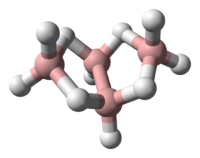Tetraborane
 |
|
| Names | |
|---|---|
|
IUPAC names
tetraborane(10)
arachno-B4H10 |
|
| Identifiers | |
| ChEBI | |
| ChemSpider | |
|
|
| Properties | |
| B4H10 | |
| Molar mass | 53.32 g/mol |
| Appearance | colourless gas |
| Density | 2.3 kg m−3 (gas) |
| Melting point | −120.8 °C (−185.4 °F; 152.3 K) |
| Boiling point | 18 °C (64 °F; 291 K) |
|
Except where otherwise noted, data are given for materials in their standard state (at 25 °C [77 °F], 100 kPa).
|
|
|
|
|
| Infobox references | |
Tetraborane (systematically named arachno-tetraborane(10)) was the first boron hydride compound to be classified by Stock and Messenez in 1912 and was first isolated by Alfred Hock. It has a relatively low boiling point at 18 °C and is a gas at room temperature. Tetraborane gas is foul smelling and toxic.
The class of boranes was elucidated using x-ray diffraction analysis by Lipscomb et. Al. in the 1950s. The x-ray data showed they have 2-electron multicenter bonds. Later, analysis based on high-resolution x-ray data was performed to analyze the charge-density. The comparison of the diffraction data from x-ray diffraction and electron-diffraction gave suspected bond lengths: B1—B2=1.84 A, B1—B3= 1.71 A, <B2B1B4= 98 ̊, B—H=1.19 A, B1—Hμ= 1.33 A, B2—Hμ=1.43 A.
The “parent” structure of boranes is referred to as closo, but when the second and third vertices are removed the new structure is B4H10 and referred to as arachno.
Boron is often called “electron deficient,” because it has three valence electrons, and the standard, carbon, has four. In reality the Boron is stable, and is no way actually deficient of electrons. To solve the issue of “deficiency” the hydrogen bridge or protonated double bonds are introduced to the structure. Each boron is sp3 hybridized and “the configuration of the three hydrogens surrounding borons B1 and B3 is approximately trigonal and suggests approximately tetrahedral hybridization for these borons which would predict bond angles of 120.” However, the Boron arrangements can be classified as fragments of either the icosahedron or the octahedron because the bond angles are actually between 105 ̊ and 90 ̊. The bonding produces a butterfly geometry in the arachno structure. The Polyhedral Skeletal Electron Pair Theory (PSEPT), originally discovered by Kenneth Wade, are often referred to as Wade’s rules. These rules can be used to count electrons in structures, such as boron hydrides.
Scientists are currently working to produce the bis(diboranyl) isomer of the arachno-tetraborane structure. The bis(diboranyl) is expected to have a lower energy at the Hartree-Fock method (HF) level. By using Wurtz reaction or coupling of B2H5I in the presence of the sodium amalgam, scientists believe they have produced the bis(diboranyl) isomer. Once the isomer was created, they tried to discover the mechanism that could then be used to turn the isomer into the arachno-tetraborane structure. Instead of discovering the mechanism, three different pathways have been constructed.
...
Wikipedia
